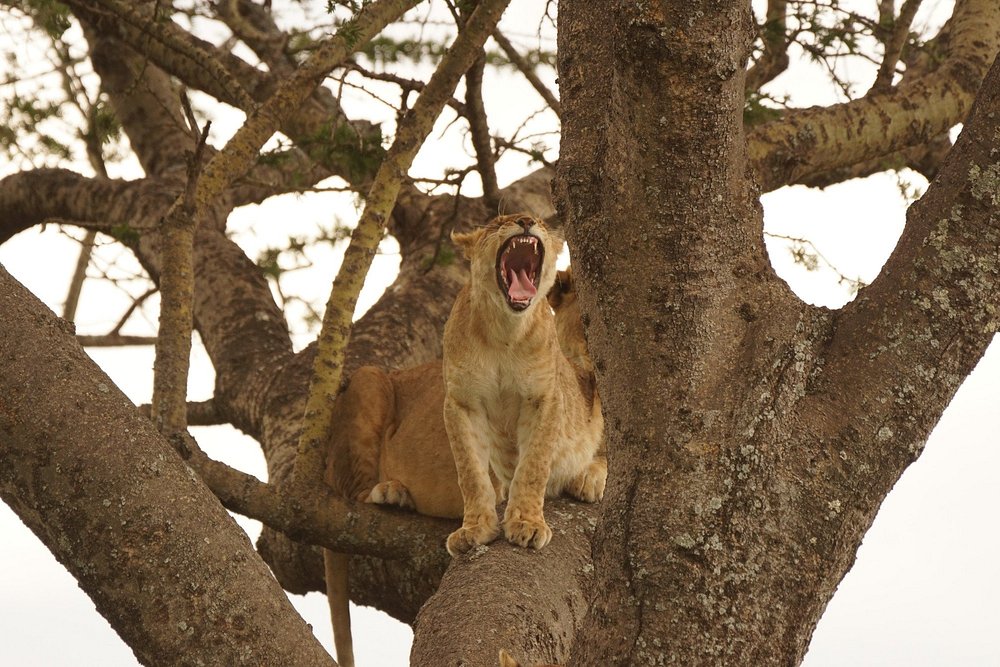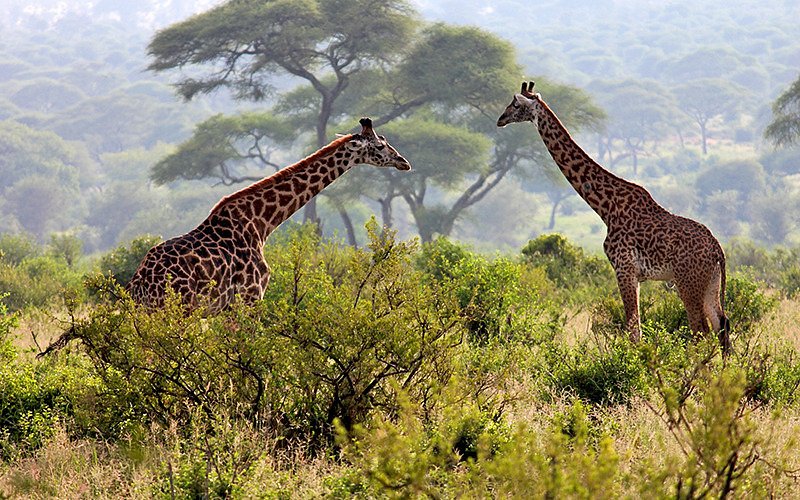Lake Manyara National Park: Home to tree climbing lions
Lake Manyara National Park is located at the base of the western Rift Valley escarpment, spanning across the districts of Karatu, Mbulu, and Babati in the Manyara region. This National Park covers a total area of about 330km², of which 200km² is covered by water, especially during the high rain seasons. This National Park also encompasses forests, woodlands, flooded plains, and escarpment slopes, all of which offer refuge to the abundant wildlife in the region. Lake Manyara National Park is a wildlife paradise in the northern Tanzania safari circuit, giving visitors epic Tanzania safaris. Many travelers from all over the world visit this national park for Big Five Safaris (witnessing; lions, leopards, rhinos, buffalo, & elephants), Birding Safaris, Walking Safaris, and to witness the unique tree-climbing lions. Safaris to Lake Manyara National Park offer visitors a blend of wildlife and nature viewing on a single Tanzania holiday tour.
Lake Manyara National Park offers one of the most epic travels in Tanzania, boasting a wide range of safari activities and experiences from boat safaris, game drives, Big Five viewing Safaris, Walking Safaris, among others. The park’s immense concentration of baboons makes Lake Manyara National Park highly recommendable for primate lovers. This park is filled with lots of gems like the hot springs, Mto Wa Mbu River, and Endabash River are good sites to spot wildlife drinking. Among the commonly spotted animals here are elephants, antelopes, zebras, lions, leopards, baboons, and warthogs, among others.
It convenient location and diversity including the large flocks of flamingos, tree climbing lions, the African Big Five (lion, leopard, rhino, buffalo, and elephant), and the rare forest-dwelling species make it one of the best safari destinations in the northern safari circuit of Tanzania.
Lake Manyara National Park History: Establishment, Conservation, & Management
History shows that the existence of Lake Manyara National Park dates back to 1920 when the colonialists (Germans) established a site for hunting around Lake Manyara. As a result the numbers of the wildlife species in the region reduced drastically and there was need to conserve the remaining animals that occupied the region. In 1929, a portion of the area was designated to protect endangered species of animals like rhinos, and elephants among others. The remote game reserve at the time needed to be further boosted to attract more tourists and it attained new status of being a national park in 1960.
The conservation project of Lake Manyara National Park was expanded in 1974 when 1,400 acres of land were added to the southern part of the park. Currently, the park stands as a narrow strip along the Manyara Escarpment of the Great Rift Valley.
This National Park is managed by the Tanzania National Parks Authority (TANAPA), a government body responsible for overseeing all the national parks in Tanzania.
The National Park protects from the unique tree climbing lions to abundant other wildlife forms, birdlife, and wetland ecosystems, among others. The conservation approaches here have integrated community based conservation through the promotion of community tourist products like visits to the nearby Mto Wa Mbu.
Activities & Attractions in Lake Manyara National Park: What to see in Lake Manyara National Park
Witnessing the Tree climbing Lions

Lake Manyara National Park
The tree climbing lions which are known for their unique skills of climbing onto tree branches, give the park its fame. Unlike other lions in other National Parks, the lions in Lake Manyara National Park have a unique adaptation of climbing the trees, especially during the hot hours of the day. Although this is extremely rare in lions, it is believed that the lions primarily climb the tress in order to flee from flies, to spot prey, and to escape other predators like hyenas. This is a unique adaptation in the Manyara making them a must see during a wildlife safari in Tanzania/Tanzania safari tour.
During Game drive safaris in the park, it is exciting to see lions hanging in trees since this is not a common behavior among lions except for leopards. As a result, a number of visitors visit Lake Manyara National Park to experience the rare behavior that lions in this part of the world exhibit. Consequently, witnessing the lions hanging in trees can be done alongside other activities like birding, wildlife viewing, among others.
Viewing the African Big Five and other Wildlife

Lake Manyara National Park
There are countless numbers of wildlife inhabiting the jungles of Lake Manyara National Park, including the Big Five animals, the tree climbing lions, leopards, elephants, buffalos, and rhinos, to hyenas, grazers like zebras, gazelles, warthogs, and hippopotamuses are also part of the large animal family. Visitors have the advantage of huge numbers to champion the spotting of animals of interest, especially the Big Five animals and birds. The authorities of the Lake Manyara National Park have simplified the game drives for visitors to reach remote sides of the park by constructing roads to expose the gems of the park.
Looking at the tones of baboons in the groundwater forest, Lake Manyara holds one of the highest concentrations of primates in Tanzania. Hippos are in abundance in Lake Manyara National Park, which makes it one of the best places to see them, especially at the hippo pool. Other commonly spotted species include; giraffes, kirk’s dik dik, banded mongoose, reedbuck, leopards, among others. Visiting Lake Manyara to see wildlife like Big Five and tree climbing lions comes in handy with more remarkable experiences which sum up an epic African Safari.
Birding in Lake Manyara National Park
Lake Manyara National Park has poised to be a leading birding destination among all the national parks in Tanzania, with many rare sightings of birds made in recent times. The birds here sing music in the ears of visitors with conducive sounds being heard throughout the day and evening hours, offering moments of relaxation to visitors. All year-round birding experiences are conducted at the Park regardless of the seasons, allowing visitors to keep track of the period and migrant bird species that visit in different times of the year. Flamingos, the palm-nut vulture, Ayre’s hawk-eagle and the crowned eagle are some of the commonest birds at Lake Manyara.
Discovering the Underground Forest
The Underground Forest of Lake Manyara is a lush green forest which covers the north of the national park, providing a livelihood to various animal and bird species. The forest is well watered with subterranean rivers, also numerous springs emanate in the green wonderland of the Park. The trees and wildlife in the underground forest are under a constant wash from the flowing streams and are evergreen since they do not rely much on the seasons for rains.
The Hippo Pool
Simba River is an iconic water body in Lake Manyara National Park, which has captured the attention of a good number of visitors. This freely flowing water of life houses a big school of hippopotamuses at the Hippo pool, which seems to never leave the water. Their constant swimming in the water allows visitors to watch the hippos with convenience without moving to other parts of the national park to search for them.
Lake Manyara
Lake Manyara is truly the heart of the wilderness of Lake Manyara National not only for the huge proportion of the park it covers, but because of the strategic importance it holds in the breeding of wildlife. Furthermore, the lake is where the national park obtains its name, which makes it the centre of attraction for visitors at Lake Manyara National Park. In this large basin, activities like canoeing and boat cruising are carried. Since most of the lake is shallow, it enables a substantial number of animals to live there and visitors can see many animals during the boat cruise.
Mto Wa Mbu Village
The band of adventure in the Lake Manyara National Park extends to cultural walks and safaris besides the Big Five safaris and adventures. Mto Wa Mbu village tells the story of communities that originally inhabited the wildlife capital of this National Park before its establishment. Mto Wa Mbu Village gives insights into the cultures and the way of life of the local people.
When to Visit Lake Manyara National Park
Lake Manyara National Park offers all-year safari experiences to visitors; however, periods from June to September and December to February are the most convenient in terms of movement for vehicles during game drives and wildlife viewing, as it is easy for one to spot animals during the dry season when the grasses are short. Animals tend to come and drink water from the waterbodies, Like Simba River, during the dry season.
How to Get To Lake Manyara National Park
By Road
For most visitors along the northern safari circuit, road transport is the most commonly used means to access Lake Manyara National Park. Visitors within the Manyara region or Arusha City can drive 126 kilometers towards the access gate. The drive to Arusha takes about 45 minutes to get to the wildlife paradise of Lake Manyara.
By Air
Flying within Tanzania is convenient due to the availability of charter flights and inland air transport services. The Charter flights are booked from the Dar es Salaam at Julius Nyerere International Airport (JIA) and the Kilimanjaro International Airport (KIA). Lake Manyara Airstrip is nearest to the park where visitors can be received by tour agents for a drive to Lake Manyara National Park.
Why Visit Lake Manyara National Park
Lake Manyara National Park offers one of the best safari experiences in Africa, making it a must-visit tourist destination, It is one of the only two places in the world where you can find tree climbing lions, and it is an amazing experience to see lions in trees.
Big Five lovers have the opportunity to see lions, leopards, buffalo, elephants, and leopards, which can be seen during the game drive, boat safaris, including the lions in trees in the acacia woodlands.
With all the large biodiversity, Lake Manyara is the place to visit for an epic African safari due to the huge number of animals, making tourists more optimistic to glance at their favorite Big Five animals and other wildlife which are found at Lake Manyara National Park.
